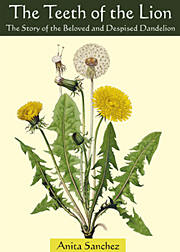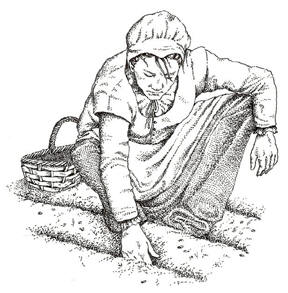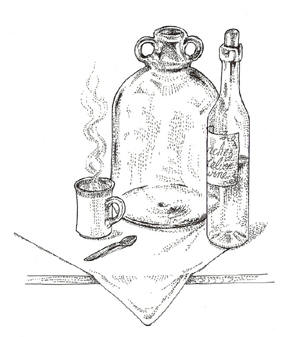 |
| Readers can learn more lore about dandelions in The Teeth of the Lion by Anita Sanchez. |
By Anita Sanchez
Whether you love them or hate them, dandelions are among the most familiar plants in the world. They’re one species that just about anyone can identify at a glance, as familiar to humans as the dog. Dandelions are, quite possibly, the most successful plants that exist, masters of survival worldwide.
Before the invention of lawns, people praised the golden blossoms and lion-toothed leaves as a bounty of food, medicine and magic. Gardeners often weeded out the grass to make room for the dandelions. But somewhere in the twentieth century, humans decided that the dandelion was a weed. Nowadays, they’re also the most unpopular plant in the neighborhood – but it wasn’t always that way.
To show the benefits of the once-beloved plant, here are 10 ten things you might not know about dandelions.
1. Dandelions have deep roots in history throughout the ages. Ancient Egyptians, Greeks and Romans enjoyed the flower, and they have been used in Chinese traditional medicine for over a thousand years. Dandelions probably arrived in North America on the Mayflower – not as stowaways, but brought on purpose for their medicinal benefits.
2. Dandelions were world-famous for their beauty. They were a common and beloved garden flower in Europe, and the subject of many poems. In the terrifying New World, the cheerful face of the dandelion was a sweet reminder of home. In Japan for instance, whole horticultural societies formed to enjoy the beauty of dandelions and to develop exciting new varieties for gardeners.
3. Dandelions are a green and growing first aid kit. The use of dandelions in the healing arts goes so far back that tracing its history is like trying to catch a dandelion seed as it floats over the grass. For millenniums, people have been using dandelion tonics to help body’s liver remove toxins from the bloodstream. In olden times, dandelions were also prescribed for every ailment, from warts to the plague. To this day, herbalists hail the dandelion as the perfect plant medicine: It is a gentle diuretic that provides nutrients and helps the digestive system function at peak efficiency.
4. Dandelions are more nutritious than most of the vegetables in your garden. They were named after lions because their lion-toothed leaves healed so many ailments, great and small: baldness, dandruff, toothache, sores, fevers, rotting gums, weakness, lethargy and depression. But it wasn’t until the twentieth century was the underlying cause of many of these symptoms realized: vitamin deficiencies. In eras when vitamin pills were unknown, vitamin deficiencies killed millions. In its time, “scurvy” was as dreaded a word as AIDS is today. Data from the U.S. Department of Agriculture reveal how dandelions probably helped alleviate many ailments: They have more vitamin A than spinach, more vitamin C than tomatoes, and are a powerhouse of iron, calcium and potassium.
 |
| A Pilgrim woman sowing seeds. Dandelions probably were brought to North America on the Mayflower for their medicinal qualities. Illustration by Joan Jobson, copyright 2007. |
 |
| Wine and tea are just two of the many uses for dandelions. Illustration by Joan Jobson, copyright 2007. |
5. Dandelions are good for your lawn. Their wide-spreading roots loosen hard-packed soil, aerate the earth and help reduce erosion. The deep taproot pulls nutrients such as calcium from deep in the soil and makes them available to other plants. While most think they’re a lawn killer, dandelions actually fertilize the grass.
6. Dandelions are masters of survival. They can take root in places that seem little short of miraculous, and then are impossible to get rid of, as homeowners have found. But why is this plant so hard to kill? It’s because they are fast growers. The sunny yellow flowers go from bud to seed in days. Their lifespan is long, too – an individual plant can live for years, so the dandelion lurking in a corner of the playground might be older than the children running past it. The roots sink in deeper over the years, and can go down 15 feet. Like the Hydra who sprouted two new heads for every one that was cut off, the roots clone when divided; a one-inch bit of dandelion root can grow a whole new dandelion. Dandelion leaves can shove their way though gravel and cement, and thrive in barren habitats.
7. Dandelions are among the most expensive items in the grocery store. Shops sell dried roots as a no-caffeine coffee substitute – for $31.75 a pound. Dandelions out-price prime rib, swordfish and lobster. They also appear in produce and other sections, and even at the liquor store. You can enjoy a complete meal, from salad greens to dandelion quiche, followed by dandelion ice cream, washed down with dandelion wine. If you over-indulge, a cup of dandelion tea is the perfect remedy, since dandelions help the liver flush hangover-inducing toxins from the body.
8. Herbicides used on lawns to kill dandelions take a terrible toll on wildlife. More than seven million wild birds are estimated to die annually due to the use of lawn pesticides. Lawns make up thirty million acres of the United States, and Americans use an estimated 80 million pounds of pesticides on them annually. The U.S. Fish and Wildlife Service reports that “homeowners use up to ten times more chemical pesticides per acre on their lawns than farmers use on crops.”
9. But there’s a safer way to have a dandelion-free lawn! Let the grass grow 3 or 4 inches tall to shade out the sun-loving dandelions, or use specialized tools like the Weed Hound to have a thriving, healthy yard that is safe for kids, pets and wildlife.
10. And at the end of the day, dandelions are just plain fun. The dandelion seems to be the flower earmarked for children: In a park or garden, it’s the only flower a kid can pick without getting into trouble. A child in a field full of dandelions can practically never run out of things to do: Blowing on dandelion puffballs can tell you if it’s time to go home, how many years until you get married, or how many children you’ll have – and of course, if you catch a flying dandelion seed, you can make a wish.
Dandelions require sun and disturbed soil to thrive. That’s why they seem to “look for” human activities: roadsides, construction sites, parking lots – and lawns. Having escaped the herb gardens a few decades ago, they now seem to be on a quest to get back into the yards they once abandoned.
Dandelions probably will never be eradicated, but we can learn to be more at ease with dandelions and other wild things – and maybe even to love them a little.
About the author: Anita Sanchez of Amsterdam, N.Y., is the author of “The Teeth of the Lion – The Story of the Beloved and Despised Dandelion,” published by McDonald and Woodward Publishing Company (mwpubco.com or 1-800-233-8787. $14.95).
Thanks for reading! Become a member today to support the creation of these resources and receive our quarterly newspaper The Maine Organic Farmer & Gardener for additional content.
